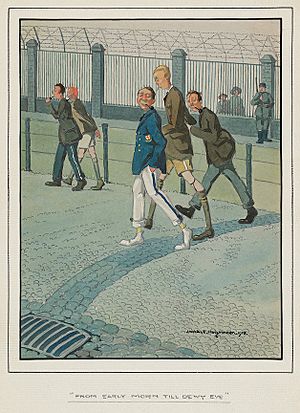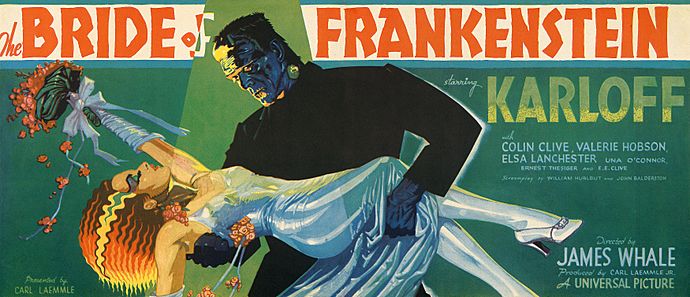James Whale facts for kids
Quick facts for kids
James Whale
|
|
|---|---|
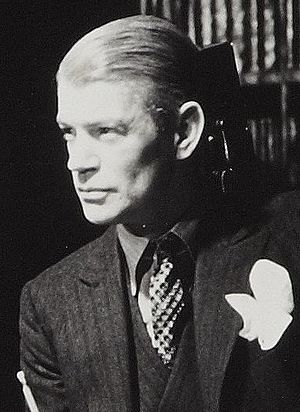
James Whale on the set of Bride of Frankenstein, 1935.
|
|
| Born | 22 July 1889 |
| Died | 29 May 1957 (aged 67) |
| Resting place | Forest Lawn Memorial Park (Glendale) |
| Occupation |
|
| Years active | 1919–1952 |
| Partner(s) |
|
James Whale (born July 22, 1889 – died May 29, 1957) was a famous English film and theatre director. He also worked as an actor. Most of his career was spent in Hollywood, USA. He is best known for directing classic horror films. These include Frankenstein (1931), The Old Dark House (1932), The Invisible Man (1933), and Bride of Frankenstein (1935). James Whale also directed movies in other styles, like the 1936 musical Show Boat.
Whale grew up in a big family in Dudley, England. He showed artistic talent from a young age and studied art. When World War I started, he joined the British Army and became an officer. He was captured by the Germans and became a prisoner of war. During this time, he discovered his interest in drama. After the war, he became an actor, set designer, and director. His success with the 1928 play Journey's End led him to the US. He first directed the play on Broadway in New York. Then, he moved to Hollywood, California, to direct movies. He lived in Hollywood for the rest of his life. He directed many films for Universal Pictures between 1931 and 1937. His movies often showed influences from German Expressionism (a style of art and film) and used a lot of camera movement.
Later in his career, Whale directed The Road Back (1937). This movie was a sequel to All Quiet on the Western Front. However, the studio changed the film a lot, possibly due to political pressure. This made the movie less successful. After a few more films that didn't do well, his film directing career mostly ended by 1941. He still directed plays and enjoyed painting and traveling. He had made good investments, so he lived a comfortable life until he had strokes in 1956. These strokes made him ill and caused him pain.
Contents
Early Life and War Experience
James Whale was born in Dudley, Worcestershire, England. He was the sixth of seven children. His father worked in a blast furnace, and his mother was a nurse. He went to several local schools. He had to stop attending in his teenage years because his family needed him to work and help support them.
Whale was not strong enough for the heavy factory jobs his brothers did. So, he started working as a cobbler, repairing shoes. He found he had artistic talent and earned extra money by lettering signs. He used this money to pay for evening classes at the Dudley School of Arts and Crafts.
When World War I began in 1914, Whale joined the British Army in 1915. He became a second lieutenant in 1916. In August 1917, he was captured by German forces in Flanders. He was held at Holzminden Officers' Camp until the war ended. While he was a prisoner, he became very involved in the camp's amateur theatre shows. He acted, wrote, produced, and designed sets. He found these plays "a source of great pleasure and amusement." He also became good at poker, and after the war, he used the money he won to help him start his civilian life.
Career in Theatre and Film
Starting in Theatre
After the war, Whale tried to find work as a cartoonist. He sold a few cartoons but couldn't get a full-time job. In 1919, he began a professional career in theatre. He learned from actor-manager Nigel Playfair. Whale worked as an actor, set designer, and director.
In 1928, Whale got the chance to direct a new play called Journey's End by R. C. Sherriff. The play was set in the trenches of World War I in March 1918. It showed the lives of British officers. Whale offered the main role to a young actor named Laurence Olivier. Olivier first said no, but then agreed. The play was very successful when it opened in London in January 1929. Critics loved it, and audiences often gave it huge applause. The play moved to another theatre and ran for two years.
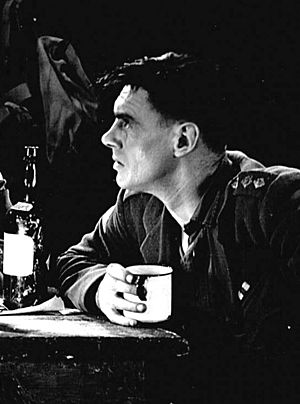
Because Journey's End was so popular, a Broadway producer named Gilbert Miller bought the rights to show it in New York. James Whale directed this version too, which opened in March 1929. This play also ran for over a year and became known as a great play about World War I.
First Steps in Hollywood
The success of Journey's End caught the attention of movie producers. At this time, movies were changing from silent films to "talkies" (movies with sound). Producers wanted directors and actors who knew how to work with dialogue. Whale moved to Hollywood in 1929 and signed a contract with Paramount Pictures. He worked as a "dialogue director" for a film called The Love Doctor (1929).
Later, Howard Hughes, a film producer, hired Whale. Hughes wanted to add sound to his silent film Hell's Angels (1930). Whale directed the parts with dialogue. After this, he went to Chicago to direct another stage production of Journey's End.
British producers bought the film rights to Journey's End. They believed Whale was the best choice to direct the movie version because he had directed the play so well. The film, Journey's End, was filmed in New York. It was released in April 1930 and was a big success with both critics and audiences.
Working with Universal Studios
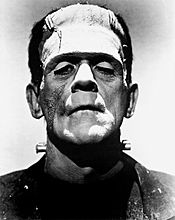
Universal Studios signed James Whale to a five-year contract in 1931. His first movie for them was Waterloo Bridge. This film was also very popular. Around this time, Whale began living with his friend and producer David Lewis.
In 1931, the head of Universal, Carl Laemmle, Jr., let Whale choose any story the studio owned to direct. Whale chose Frankenstein. He picked it because he wanted to make something different from war movies. The story was based on Mary Shelley's 1818 novel Frankenstein; or, The Modern Prometheus. Whale cast Colin Clive as Henry Frankenstein and Boris Karloff as the Monster. Filming began in August 1931. When Frankenstein was released in November, it was an instant hit. It received great reviews and broke box office records.
Whale's next films were The Impatient Maiden and The Old Dark House (both 1932). The Impatient Maiden wasn't very memorable. But The Old Dark House, starring Karloff and Charles Laughton, is known for changing horror films.
Whale's next movie was The Kiss Before the Mirror (1933), which critics liked but didn't make much money. He then returned to horror with The Invisible Man (1933). This film mixed horror with humor and amazing visual effects. It was highly praised, and The New York Times listed it as one of the ten best films of the year. It also broke box-office records.
In 1933, Whale also directed the romantic comedy By Candlelight, which was well-received. In 1934, he directed One More River, based on a novel.
Bride of Frankenstein (1935) was Whale's next big project. He had not wanted to make a sequel to Frankenstein at first. The movie was based on a part of Mary Shelley's original novel where the Monster asks Frankenstein to make him a partner. The film was a big success and is often called Whale's masterpiece.
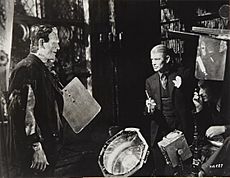
After Remember Last Night?, Whale immediately started working on Show Boat (1936). He brought together many people who had worked on the musical before, including Helen Morgan and Paul Robeson. Many critics believe the 1936 version of Show Boat is the best film version of the musical.
Show Boat was the last of Whale's films made under the Laemmle family, who owned Universal. The studio went bankrupt, and new owners took over.
Career Changes
Whale's career slowed down after his next film, The Road Back (1937). This movie was a sequel to All Quiet on the Western Front. It followed German soldiers returning from World War I. The German consul in Los Angeles protested the film, saying it showed a "distorted picture of the German people." He even threatened actors. The studio made changes to the film, which made Whale very angry. The altered film was banned in Germany and several other countries.
After this, the new head of Universal tried to end Whale's contract. Whale refused. So, he was given a series of less important films to direct. Whale only made one more successful feature film, The Man in the Iron Mask (1939), before he mostly stopped directing films in 1941.
Life After Film Directing
After his film career, Whale had more free time. He was offered some jobs but turned them down. His friend David Lewis was very busy, so Whale felt lonely. Lewis bought him paints and canvases, and Whale rediscovered his love for painting. He even built a large art studio.
During World War II, Whale volunteered to make a training film for the United States Army in 1942. Later that year, he started a theatre group called the Brentwood Service Players. They performed plays, and 60 seats were given free to service members. The money from other tickets was donated to wartime charities.
Whale returned to Broadway in 1944 to direct a play called Hand in Glove. It was his first time directing on Broadway in many years, but the play only ran for a short time.
Whale directed his last film in 1950. It was a short movie based on a play called Hello Out There. This film was never released to the public.
In 1956, James Whale had a small stroke. A few months later, he had a larger stroke and was hospitalized. He was treated for depression while in the hospital.
Death
James Whale passed away on May 29, 1957, at age 67. His body was cremated, and his ashes were placed in the Columbarium of Memory at Forest Lawn Memorial Park, Glendale. When his longtime friend David Lewis died in 1987, his ashes were placed near Whale's.
Filming Style
Whale was greatly influenced by German Expressionism, an art movement that used distorted shapes and strong emotions. He admired films by Paul Leni that mixed horror and comedy. This influence was very clear in Bride of Frankenstein and Frankenstein. In Frankenstein, Whale used both distorted, expressionistic shots and more regular filming styles. The Monster's look, acting, and costumes also showed this influence.
Whale was also known for how he moved the camera. He is believed to be the first director to use a 360-degree panning shot (where the camera rotates all the way around) in a movie, which he did in Frankenstein. He used a similar technique in Show Boat when Paul Robeson sang "Ol' Man River". Whale often used a series of shots to introduce characters, starting with a medium shot and ending with close-ups. He used this in Frankenstein, The Invisible Man, and One More River.
Legacy and Recognition
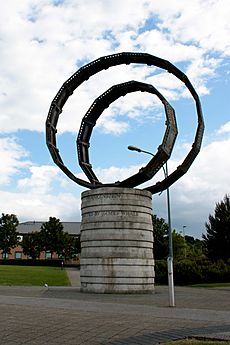
Film critic Andrew Sarris called Whale "lightly likable" in his 1968 ranking of directors. He said that Bride of Frankenstein was the "true gem" of the Frankenstein movies. Sarris noted that Whale's career showed the artistic goals and challenges of an expressionist director working in Hollywood in the 1930s.
James Whale's last months are the subject of a novel called Father of Frankenstein (1995) by Christopher Bram. This novel was made into the 1998 film Gods and Monsters. In the film, Ian McKellen played Whale and was nominated for an Academy Award for his performance.
Only two of Whale's films received Oscar nominations: The Man in the Iron Mask (for its music) and Bride of Frankenstein (for its sound).
A sculpture honoring James Whale was put up in September 2001 in his hometown of Dudley, England. The sculpture, made by Charles Hadcock, looks like a roll of film with the face of Frankenstein's monster carved into it. The names of his most famous films are etched into the base.
An art show called Horror in Hollywood: The James Whale Story displayed Whale's artwork. It was held at the Dudley Museum and Art Gallery from October 2012 to January 2013.
Filmography
| Title | Year | Notes |
|---|---|---|
| Journey's End | 1930 | First film directed |
| Hell's Angels | 1930 | (Directed dialogue) |
| Waterloo Bridge | 1931 | |
| Frankenstein | 1931 | |
| The Impatient Maiden | 1932 | |
| The Old Dark House | 1932 | |
| The Kiss Before the Mirror | 1933 | |
| The Invisible Man | 1933 | |
| By Candlelight | 1933 | |
| One More River | 1934 | |
| Bride of Frankenstein | 1935 | |
| Remember Last Night? | 1935 | |
| Show Boat | 1936 | |
| The Road Back | 1937 | |
| The Great Garrick | 1937 | |
| Port of Seven Seas | 1938 | |
| Sinners in Paradise | 1938 | |
| Wives Under Suspicion | 1938 | |
| The Man in the Iron Mask | 1939 | |
| Green Hell | 1940 | |
| They Dare Not Love | 1941 | Final feature film |
See also
 In Spanish: James Whale para niños
In Spanish: James Whale para niños


